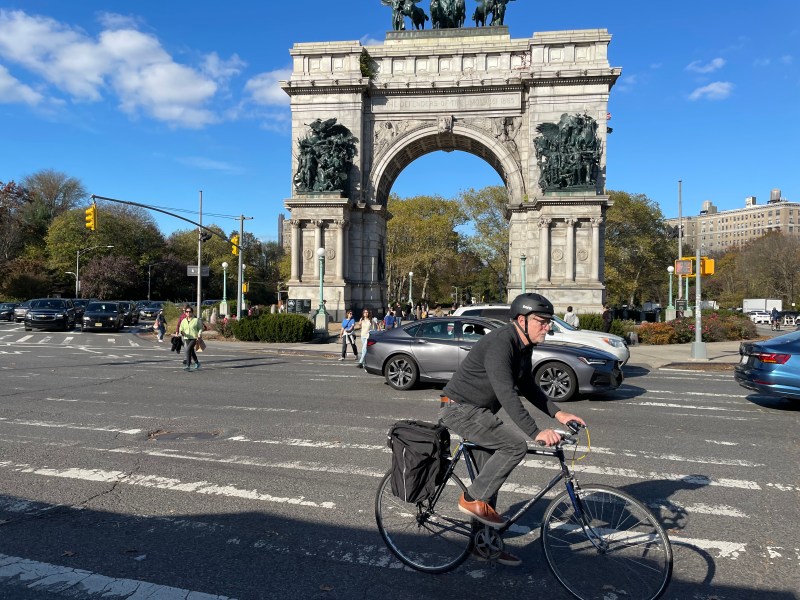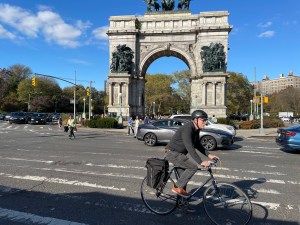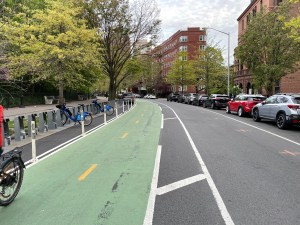DOT Kicks Off Outreach on New Grand Army Plaza Fix: ‘Dream Big’

The journey of a thousand meetings begins with a single tabling.
The Department of Transportation set up shop at Grand Army Plaza on Saturday, the last nice day of the year, to present a first look at its latest effort to build more space for pedestrians and cyclists to make the current car sewer worthy of its lofty name. The agency insisted that a car-free GAP was not in play, but did float a long-desired idea to connect the northern entrance of Prospect Park to the Soldiers Memorial Arch that would change the chaotic traffic circle into a kind of traffic horseshoe.

Planners from the DOT’s pedestrian unit first threw cold water on someone else’s previous reporting that the plaza could go totally car-free, but the basic illustrations that the agency showed off included a design that hearkened back to a 2007 proposal that would extend the pedestrian plaza at the entrance of Prospect Park to the sidewalk in front of the Soldiers and Sailors Memorial Arch to create a unified park entrance instead of a cut through for drivers between Union Street and Eastern Parkway.
Crucially, the agency is promising to spend capital dollars on the plan, instead of just putting down some paint and planters and hoping for the best.
“I’ve been working on Grand Army Plaza for 15 years,” said Terra Ishee, the director of the DOT Pedestrian Unit. “We’ve done all that we feel like we can do with the resources we have in-house, so we really need to bump it up and make it a full blown capital project.”
As a reminder: Currently, Grand Army Plaza is comprised of the northbound and southbound lanes of Flatbush Avenue surrounding a huge Civil War memorial arch that is virtually impossible to get to and, as such, is under appreciated and under visited. Two service roads, Plaza Street East and West, serve as the outer ring of the plaza, with traffic flowing in a counter-clockwise manner and connecting to various spokes, such as Vanderbilt Avenue into Prospect Heights and Lincoln Place into Park Slope. Eastbound Union Street forms the bottom of the plaza and is a congested roadway that drivers use to get to congested Eastern Parkway.
The Saturday outreach was the first piece of a multiyear design process that the DOT said would take until 2024 and work on a timeline that includes the planned upgrades to the Vanderbilt and Underhill avenues that are supposed to be installed in 2023. Such an upgrade can be radical — such as closing Union Street between Plaza Street West and Plaza Street East to cars and connecting the plaza to the park (see graphic above) — or minor (see graphic below).
The outreach for Grand Army Plaza includes a virtual meeting on Wednesday at 6:30 p.m. and an online survey. It and will also include a traffic study by the DOT and the Department of Design and Construction in 2023.
Volunteers at the two Prospect Heights open streets said that they had been pushing the DOT for big changes at the nearby memorial plaza.
“There’s been a series of letters and meetings,” said Prospect Heights Neighborhood Development Council Vice Chair Saskia Haegens. “Most of that focused on what DOT calls street improvement projects, the ‘paint-and-planters’ approach. But we’ve asked for speed bumps and to flip the bike lane on Plaza Street East and West to make a parking-protected bike lane, and longer term changes that we would like to see or believe should be considered would include closing portions of the plaza to traffic and connecting the fountain and the park as has been proposed previously.”

A preliminary design for the upgraded plaza won’t be revealed until the summer of 2024, but Ishee said the wait could be worth it since the agency is dreaming big. Residents in the area who showed up to the tabling session are also thinking big.
“I like the idea that connects the arch to the park,” said Michelle Debczak, who said she lives near the plaza. “[Grand Army Plaza] is such a beautiful historic space, but it’s really empty; it’s just a waste of green space. So I think that would help a lot if we were able to connect it to the park.”
Even if the eventual design doesn’t banishes cars, the use of capital dollars for the stated goal of improving bike and pedestrian safety in the area means the process is shaping up to be the most ambitious redesign of Grand Army Plaza since the DOT unveiled major changes to the area in 2011. (Note to aspiring politicos: the roster of elected officials celebrating the completion of the project in 2011 include people who went on to become the Attorney General of New York State, mayor of New York City and the third-ranking member of the House of Representatives. Safe streets save lives of constituents who can vote for you later.)
But even that project, which transformed what then-DOT Commissioner Janette Sadik-Skhan called “a vicious traffic circle” into a safer area for cycling or walking left a lot to be desired. The bike lanes around Plaza Street which were pitched as protected remain only paint, and wonky signal timing on the Flatbush Avenue side of the plaza in front of Prospect Park means people are constantly stranded between rows of speeding cars between the Brooklyn Public Library and the park.
Advocates said they’re ready to fix that, among other things.

“In the current configurations there are enormous challenges with signal timing, which is why people get stuck between the library and the greenmarket on that little island,” said Eric McClure, the executive director of StreetsPAC and the incoming chairman of Brooklyn Community Board 6. “I think there is a lot that can be accomplished there in terms of traffic, calming, and making it a better pedestrian and cycling space.”
In May 2022, Council Members Crystal Hudson and Shahana Hanif asked the DOT to fix the issues that existed since the 2011 fixes, including the signal timing around the plaza, refurbishing broken concrete, upgrading the painted bike line and doing a previously promised traffic study in the area. The letter pointed out that despite the well-received changes to the area, Grand Army still posed a safety risk, and that a mother and her 1-year-old child were among the 89 people hurt in the hurt in crashes in the area between 2017 and 2021.
What comes next will depend in part on a series of meetings and the usual agita engender by ambitious street redesign projects. Planners at Saturday’s outreach fielded plenty of questions, comments and complaints, including from one area resident who angrily told a planner that he wouldn’t accept a car-free Grand Army Plaza before changing gears to say the proposed redesigns that greatly reduced the roadway in the area were something he could live with. And the agency’s willingness to think about closing the traffic circle was music the ears of veterans of the fight to fix Grand Army Plaza, which has gone on for most of the 21st century.
“What they showed here is not the limit of possibilities,” said Michael Cairl, who helped found the Grand Army Plaza Coalition, a group that fought for the first batch of safety upgrades for the plaza. “But just the fact that they’re taking action here and not only looking at existing traffic, but at the space itself, is so important.”
Join us for a workshop to gather ideas for the long term capital vision for Grand Army Plaza in #Brooklyn.
11/12, 10AM-1PM: Grand Army Plaza Farmer’s Market
11/16, 6:30PM: Virtual workshop, register here: https://t.co/lhphRjhi0M
Share feedback online: https://t.co/iPzPZ2vQQH pic.twitter.com/WJXGGBlszf— NYC DOT (@NYC_DOT) November 8, 2022

